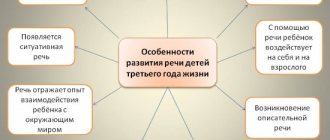Bradylalia is a pathology in which a child speaks very slowly. Experts qualify it as a violation of the tempo and rhythm of speech, which is not convulsive in nature. Bradylalia manifests itself as:
- independent disorder. This type of pathology is typical for slow, overly calm and lethargic children;
- symptom of the disease. A child may begin to suffer from bradyllalia due to acquired or congenital mental retardation, with dystrophic or organic lesions of the central nervous system, or after suffering infectious diseases. In this case, the child experiences a slowdown not only in speech, but also in movements. Children speak poorly, get tired quickly, feel weak and lethargic.
Experts distinguish between different degrees of bradyllalia. In some cases, the child speaks slightly slowly, which is almost imperceptible to the people around him. With more severe degrees of pathology, problems with adaptation in society and developmental delays may be observed. Cerebellar bradyllalia is in its own category. It is characterized by scanned speech.
Signs of bradylalia
The presence of bradyllalia in a child can be determined by the presence of verbal and non-verbal symptoms. In the first case we observe:
- slowdown in spoken speech;
- the occurrence of delays between words and sounds while the child speaks (the baby can stretch out vowels);
- monotony of voice, pronunciation of sounds “in the nose”, nasality;
- stretching out syllables and sounds (although children say all the words absolutely correctly);
- the child's slowness in reading and writing.
Nonverbal signs include:
- violations of facial expressions and motor skills;
- inattention, lethargy and poor coordination;
- deterioration of attention, memory and thought processes;
- difficulty switching from one activity to another (the child may also experience repetition of the same movement);
- isolation, silence and very difficult adaptation.
If your child speaks slowly, it may simply be a manifestation of his temperament. However, parents should not ignore this problem. Contacting specialists to correct the pathology will allow the child to get rid of bradylia and lead a full life.
Article:
The pace of our speech is one of the important means of expression. The significance of a statement often depends on intonation and slowness of speech flow. Increasing the pace of speech, on the contrary, indicates the interlocutor’s desire to skip unnecessary details or add an emotional coloring to the event being described. Impaired speech rate has become a common speech disorder in children in recent years. It’s not even stuttering, but either a slow tempo - bradyllalia, or an accelerated tempo - tachylalia. If you do not pay attention to these violations from early childhood, a person will enter adulthood with blurred, slurred, monotonous or accelerated speech with hesitations. The reasons for poor speaking tempo can be different. The work to eliminate them will also be appropriate. Tahilalia The normal rate of speech is when we pronounce 9-13 sounds per second. If the number of sounds significantly exceeds this “limit”, then we can talk about tachylalia - an accelerated rate of speech (20-30 phonemes per second). Such rapid-fire words are very difficult to understand. In this case, sound pronunciation may correspond to the norm, but the speaker skips, repeats or rearranges syllables, and distorts words. A stream of words is spoken continuously in one exhalation. The speaker often interrupts the interlocutor, chatters incessantly, accompanying his statements with disordered rapid movements of his arms, legs and whole body. The same pace is characteristic of internal speech. Thought cannot keep up with speech. Errors also occur when reading and writing: omission, replacement, rearrangement of syllables, distortion of the sound shell of words, replacement of words with completely different ones that sound similar. Most preschool children speak very quickly and do not yet know how to control the flow of speech. This is due to the fact that their inhibitory processes are still developing, and children do not know how to control them. The immoderate pace of their babbling is often associated with imitation of adults. At the same time, the baby can either chatter without interruption, or slow down his sound flow. From early childhood, it is necessary to cultivate in a child a culture of reproducing words, regulating tempo and intonation. Causes and forms of tachylalia If a child chatters randomly without slowing down, this may be a cause for concern. With tachylalia, the child also has non-speech symptoms, which are manifested by impaired general motor skills, nervous twitching of the limbs, and behavioral disorders. The child sleeps restlessly at night, rushes about in his sleep, and during the day the processes of excitation prevail over the processes of inhibition. Children are quick-tempered, experience constant mood swings, a sharp outburst of emotions, and aggression. Attention is impaired, there is no concentration on one object, there is frequent switching, low volume of visual and motor memory. During excitement, tachylalics experience redness of the ears, sweating (sweat may also appear on the forehead) or coldness of the palms, and an inability to articulate in accordance with the flow of thoughts. The cause of tachylalia is considered to be improper functioning of the areas of the brain that are responsible for the central speech apparatus. Often, speech tempo problems are hereditary. Accelerated speech may occur in children of parents who stutter. One of the reasons is congenital insufficiency of the speech motor apparatus, difficulty in articulation, as well as speech sloppiness in adults. Children who are in speech conditions in which family members have an uneven, uncontrolled verbal flow, in which the fast pace of their speech is not corrected, begin to babble quickly and unintelligibly by imitation. The combination of impaired motor and acoustic perception leads to the occurrence of tachylalia. There are two types of tachylalia: poltern (stumbling) and battarism. Stumbling is often confused with stuttering because the speaker frequently repeats the same sounds and syllables. However, such “jumping” of phonemes is not stuttering, because during their production there are no muscle spasms of the speech apparatus, characteristic of logoneurosis. Battarism is characterized by distorted phrase construction due to a lack of verbal attention. This is rearranging syllables in a word, eliminating syllables and sounds from words, leaving out endings, clumsy formatting of statements, replacing one word with another that sounds similar. Correction of tachylalia Work to eliminate the defect must be comprehensive. Medical intervention with the help of medications, physiotherapy, and special types of exercise therapy is mandatory. Speech therapy classes should include logorhythmics, musical accompaniment, exercises aimed at developing logical thinking and concentration. Correctional work lasts from 9 months to a year and always in a group form. In a group of children with similar disabilities, the child listens to the speech of others, where it is easier to create a problematic play situation. At first, children speak by imitation at a very slow pace, far from normal. The speech therapist sets the rhythm, which is accompanied by tapping on the table and clapping the rhythm of words and phrases with one's hands. Phrases and rhymes are spoken to the accompaniment of slow music. It is useful to march with your arms out to the sides and pronounce words as the ball hits you. At home, parents can also practice day after day, saying phrases at a slow pace, tapping a tambourine, using leisurely music. You can also smoothly sing vowel sounds repeatedly in the following sequence: “iiiiii, eeeee, aaaaa, ooooo, uuuuu...” Everyday training leads to a slower rate of speech. After this, you can move on to exercises that develop expressiveness and clarity of speech. This is memorizing nursery rhymes, poems with emotional overtones, reciting poetry, clearly pronouncing simple sayings. Tachylalics often have problems with the sequence of speech, so it is useful to train them in planning speech utterances. Compose a story from a series of plot pictures or based on a ready-made plan, suggesting the sequence of events. One of the effective means of storytelling is the game “get the word out.” The speech therapist begins the phrase, and each of the children takes turns finishing it. Phrases should be united by one topic, which develops logical thinking in children and allows them to practice mastering a leisurely pace of speech. During and after the completion of the correction course, close adults need to monitor their speech at home and monitor the child’s speech. Tahilalia tends to return if the necessary speech environment is absent in the family. After a year has passed after the rate of speech has normalized, we can say that tachylalia has disappeared. Bradylalia Also occurs in preschool children. It is often called bradyphrasia, in which the rate of speech is excessively slow, vowel sounds are stretched, there are long pauses between words and weak, semi-fluid articulation. Bradylic patients are characterized by lethargy and sluggish movements. The facial muscles are inactive, the fingers are weak, there is hypotonicity of the limbs, general awkwardness and clumsiness, the voice is either loud or quiet. Mental activity also slows down: internal speech and thinking are inhibited, attention is scattered, it is difficult to switch from one type of activity to another, memory is short-term, perception is impaired. Children cannot understand the instructions the first time and have difficulty navigating in space. Persistent errors are also observed in writing: omission of words and entire phrases, distortion of the meaning of statements. More often than others, mentally retarded children suffer from bradylalia. The disease also occurs in combination with mental retardation, meningoencephalia, and brain tumors. The cause of bradyphrasia is disruption of the brain, the dominance of inhibitory processes over excitation processes. This can be either a hereditary phenomenon or a social one, due to imitation or improper speech education. Correction of bradylalia The speech of a bradylalia person is unaesthetic, tiresome for others, and sometimes causes irritation. The correction must be carried out in consultation with a neuropsychiatrist. An integral part of the treatment will be drug intervention and special types of physical therapy. The goal of the speech therapist’s work is to develop clear articulation, rapid rhythm of movements, and strengthen the muscles of the fingers. Massage of the tongue, lips, cheeks, articulation exercises must be done every day. Logo-timing in group classes will help normalize the pace of words and movements. A very good exercise is rhythmic marching. Running to music with frequent changes of actions in accordance with changes in the nature of the music, various outdoor games with pronunciation contribute to the development of the general tempo of movements, switching of attention and auditory perception. All classes are conducted at an accelerated pace. The speech therapist carefully models a normal speaking rate using an easy-to-pronounce sentence spoken aloud. The tempo is then quickened by clapping or conducting the phrase. Children repeat movements and words several times until they achieve a normal rhythm. At home, parents also train their children by clapping lines of poetry repeatedly. Children repeat, gradually increasing the pace of speech following the accelerating claps. At the same time, it is important to ensure that the child does not become overtired and give him a rest every 10 minutes. The next stage will be for the children to exercise themselves in quickly reproducing one line at a time of the memorized verse. The adult points to the child, who quickly says a line. It is necessary to include elements of “deception” in play activities: the speech therapist looks at one child and points at another. In an emotional atmosphere, skills are learned faster, and auditory and visual attention develops. Then you can use role-playing of the fairy tale. In teamwork, the child’s task will be not to let his friend down and to let him speak in time. At the same time, the speech therapist encourages and achieves acceleration of the tempo of speaking, as well as expressiveness of speech. At the last stage of work, it is necessary to memorize tongue twisters, learn to pronounce them clearly, quickly, without hesitation or distortion. Using the material of reciting tongue twisters, normal sound skills are consolidated and memory is developed. Corrective work lasts 10-12 months. Parents need to remember that speech culture develops primarily in the family. It is important to monitor your own speech and correct your child in case of speech errors. It is necessary to create a healthy emotional climate, taking care of the favorable development of the child’s nervous system at the formative stage. If disturbances in the rate of speech are detected, it is necessary, without delay, to contact a neurologist.
Causes
Children speak very slowly for a variety of reasons. The main factor in the development of bradyllalia is the strengthening of inhibitory processes, which over time begin to prevail over excitatory processes. Speech therapists distinguish physiological and psychological causes of pathology.
A child can inherit bradyllalia or acquire it as a result of perinatal damage to the central nervous system. It is also a symptom:
- oligophrenia;
- Parkinson's disease;
- brain injuries;
- meningitis;
- depressive disorder;
- brain tumors;
- encephalitis.
Children speak measuredly and very slowly due to lack of speech training or by imitating a loved one. Pathology can also develop due to decreased mental function and mental retardation. Very often, bradyllia appears in phlegmatic children. Such a child is naturally inhibited and slow.
How to understand that a child does not understand speech
Adults may mistakenly think that the baby does not perceive their speech well. Therefore, it is important to distinguish the norm from deviation. There are main signs of the disorder:
- Impaired understanding. In this case, the child:
- does not respond to calls to him, as if he were deaf;
responds to whispers, but not to loud speech;
- does not respond;
- does not understand the same request formulated differently;
- confuses the meaning of questions and gives answers at random;
- when responding to a phrase, pays special attention to the adult’s facial expression;
- requests made in an unusual environment are met with confusion and misunderstanding;
- constantly repeats the question asked.
- Reflection of adult behavior. The child often repeats the gestures of the person talking to him or phrases heard from cartoons and television shows. He does this unconsciously, considering this to be his own initiative. The stronger the disorder, the more repeated phrases are found in his speech.
- Possibility of initiation. Despite poor understanding, the child can still start a conversation first with the correct phrases and engage in dialogue.
- Reduced communication. The child remembers how his previous attempts to maintain a conversation ended, when phrases inserted incorrectly in meaning led to aggression or ridicule. Such negative experiences cause him to avoid all social interactions. Among his peers, he prefers to communicate with quiet guys and not get involved with active “ringleaders”.
- Increased productivity on visual tasks explained in nonverbal ways.
- Striving for consistency. A child with this disorder will always want to keep his social circle unchanged due to the lack of understanding of other adults.
- Increased anxiety. This is not a symptom of the receptive disorder itself, but is caused by an adaptation disorder. The environment and family directly influence the degree of anxiety of the child.
- Obsessive actions. Lip biting, finger wringing, and many other habits are signs of tension caused by maladjustment.
- Inability to control your behavior. Children with receptive disorder are often hyperactive and impulsive. In the absence of an adult who regulates his actions, this manifests itself especially strongly.
If several of the listed symptoms coincide with the child's behavior, but you are not sure that he has a receptive disorder, the following tests can be performed.
For a child from 1.5 to 3 years old
Ask your child to bring any item: toys, fruits, vegetables. If he fulfills the request or simply looks at the named thing, then he has no violation.
For a child 3 years or more
A baby can be considered healthy if he is able to:
- Fulfill any complex request. For example, take a toy and put it in a box.
- Point to pictures with a specific action. For example, find a person who is eating or sleeping.
When testing, it is worth considering that the child may know exactly the set of words that are required of him. Therefore, this method cannot be considered completely reliable.
Diagnosis of bradyllalia
Parents of a child who speaks slowly should seek professional help. A comprehensive examination may require the participation of a neurologist, psychiatrist, speech therapist and psychologist. Instrumental studies are used to identify the physiological causes of speech pathology. The child may be prescribed:
- MRI of the brain;
- PAT;
- rheoencephalography;
- EEG, etc.
In addition, the child is examined by a speech therapist. He conducts speech diagnostics to determine the degree of bradyllalia and select an effective correction method.
How should parents behave if their child does not understand spoken language?
It can be very difficult for mom and dad to raise a child with a receptive disorder because the child does not pay attention to the adult's speech. Due to his unstable behavior, increased anxiety and whims for no apparent reason, it seems impossible to train him in any way to perceive the information he hears.
However, do not despair and be left alone with the problem. It is necessary to contact specialists so that they can comprehensively understand the violation and develop an effective correction method. The neuropsychologist at the La Salute clinic not only conducts diagnostics to identify the source of abnormalities, but also helps stimulate the development of children with various forms of disorders.
Correction of speech pathology
If a child speaks slowly due to physiological disorders, then therapy is aimed at eliminating the underlying disease. First of all, treatment involves normalizing the functioning of the central nervous system. Complex therapy may include:
- taking medications. Strengthening and stimulating medications, as well as vitamin complexes, are selected for the child. Medicines containing glutamic acid are actively used;
- physical therapy. Water activities, swimming, massage and physiotherapeutic procedures are very effective;
- consultations with a psychotherapist. Sessions with a psychologist are also possible to overcome emotional problems. A child who spoke slowly for a long time could withdraw from society and lose self-confidence;
- educational games. The child will benefit from activities that improve motor skills, facial expressions and emotional speech. For example, children benefit from acting lessons and stage performances. The child also needs to read more, solve riddles, learn and sing rhythmic songs;
- manual labor. Assembling construction sets, embroidering and other activities help develop fine motor skills. The child's speech rate improves when learning dance moves. Physical education and sports will not be superfluous.
Of course, a child who speaks very slowly needs the help of qualified teachers and speech therapists. This is one of the most important parts of treatment.
How are classes with a teacher going?
For a child suffering from slow speech, the most effective correction method is logarithmics. During classes, kids run, march, or perform other physical exercises to rhythmic music. Games are also played, accompanied by the pronunciation of various sentences and words.
The child’s speech in classes with the teacher is gradually stimulated. Correction classes include four main stages.
- The teacher pronounces a very simple sentence, for example, “sa-sa-sa is a fox walking through the forest.” At the same time, he sets the pace by clapping, tapping on the table or moving his hands. The child needs to repeat the sentence several times. The pace set by the teacher gradually increases. Therefore, the child has to say the phrase faster and faster.
- The child is asked to learn a few simple poems. Then he must quickly recite lines from them. If the child already knows poems, then you can use his favorite ones.
- At the third stage, the child needs to learn not only a fast pace of speech, but also its expressiveness. Therefore, during classes, children speak in roles, acting out excerpts from fairy tales.
- At the last stage, children learn tongue twisters. This allows the child to consolidate the skills acquired during the correction.
Timely detection of bradyllalia in a child makes it possible to begin correction. An integrated approach to eliminating pathology allows you to achieve good results. However, in addition to classes, the child needs the help of parents. They must be careful to ensure that the baby does not start speaking slowly again. It is recommended to repeat poems and tongue twisters at home.
Speech norms for children
Knowing what children should be able to do at different ages helps judge the presence or absence of pathology.
| Age | Norm for development of auditory skills |
| From 0 to 1.5 years | The child listens to the parent’s voice and reacts to intonation. Distinguishes the voices of loved ones, knows his own name. Accepts simple requests, for example, to stop doing something or to give a hand. By the age of 1.5 years, he begins to understand the names of some objects and recognizes them in pictures. |
| From 1.5 to 2 years | The child can point to a specific action in a plot drawing, for example, show who is sleeping or eating |
| From 2 to 3 years | Able to carry out requests with multiple actions, such as walking into another room and taking an apple from a cup. Understands fairy tales and stories heard |
| From 4 to 5 years | The child perceives complex sentences, as well as the meaning of various prepositions |
Prognosis and prevention
In most cases, the prognosis for bradyllalia is favorable. Especially if the parents noticed in a timely manner that the child spoke slowly and turned to specialists for help. However, after a successful correction, you should not let your guard down. As a preventive measure it is recommended:
- lead a healthy lifestyle and follow doctors’ recommendations during pregnancy;
- protect the child from traumatic brain injuries and infectious diseases;
- maintain a daily routine and diet;
- ensure that the child develops speech and work with him;
- talk to the baby, teach poems and songs.
Slow speech is not always a symptom of a disease. In most cases, lessons with a teacher are sufficient. Therefore, you should not worry too much when signs of bradylia appear. But if you are worried about your baby, then contact the NEAPL speech therapy and psychology center. Experienced teachers will help correct speech disorders.










